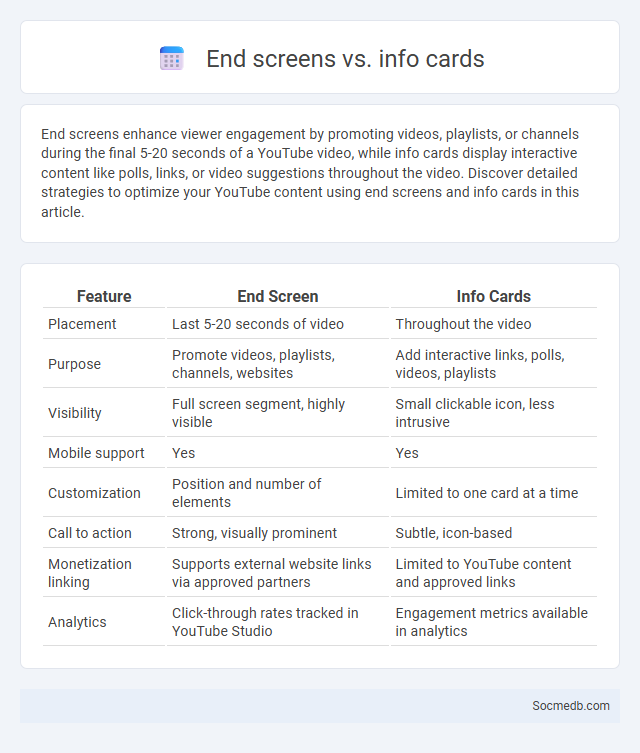
Photo illustration: End screen vs Info cards
End screens enhance viewer engagement by promoting videos, playlists, or channels during the final 5-20 seconds of a YouTube video, while info cards display interactive content like polls, links, or video suggestions throughout the video. Discover detailed strategies to optimize your YouTube content using end screens and info cards in this article.
Table of Comparison
| Feature | End Screen | Info Cards |
|---|---|---|
| Placement | Last 5-20 seconds of video | Throughout the video |
| Purpose | Promote videos, playlists, channels, websites | Add interactive links, polls, videos, playlists |
| Visibility | Full screen segment, highly visible | Small clickable icon, less intrusive |
| Mobile support | Yes | Yes |
| Customization | Position and number of elements | Limited to one card at a time |
| Call to action | Strong, visually prominent | Subtle, icon-based |
| Monetization linking | Supports external website links via approved partners | Limited to YouTube content and approved links |
| Analytics | Click-through rates tracked in YouTube Studio | Engagement metrics available in analytics |
Introduction to YouTube End Screens and Info Cards
YouTube End Screens enhance viewer engagement by promoting related videos, playlists, or channels during the last 5-20 seconds of your video, increasing watch time and subscriber growth. Info Cards provide interactive elements, such as links to external websites, polls, or other videos, visible throughout the video to boost click-through rates and viewer interaction. Optimizing End Screens and Info Cards is crucial for maximizing YouTube channel performance and expanding your audience reach.
What Are End Screens?
End screens are interactive elements on social media videos that encourage viewer engagement by promoting actions such as subscribing, watching more content, or visiting external links. These visual prompts typically appear in the final 5-20 seconds of a video, enhancing audience retention and driving traffic to additional videos or playlists. By using end screens effectively, you can increase your channel's growth and viewer interaction.
What Are Info Cards?
Info Cards are interactive elements on social media platforms designed to provide users with concise, relevant information without leaving the app or webpage. They often include key details such as event dates, product descriptions, or user profiles, enhancing your browsing experience by making essential data easily accessible. By integrating Info Cards, social media channels improve engagement and streamline the flow of information.
Key Features of End Screens
End screens on social media platforms enhance viewer engagement by directing audiences to additional content, website links, or subscription options during the final 5 to 20 seconds of a video. Key features include customizable templates, clickable elements such as video thumbnails or subscribe buttons, and the ability to track interaction metrics for performance analysis. This interactive tool increases click-through rates and viewer retention, making it essential for content creators aiming to boost channel growth and audience connectivity.
Key Features of Info Cards
Info Cards on social media platforms enhance content sharing by providing concise summaries, clickable links, and visually engaging elements such as images or videos. These cards improve user interaction through metadata integration, enabling better preview displays across feeds and timelines. Optimized Info Cards increase click-through rates and amplify content visibility by facilitating seamless sharing and better user engagement metrics.
Comparing Engagement Rates: End Screens vs Info Cards
End screens on social media videos typically yield higher engagement rates by providing direct calls-to-action during the video's final moments, encouraging viewers to subscribe, watch more videos, or visit external links. Info cards appear throughout the video and can increase interaction without interrupting content flow, but they often achieve lower click-through rates compared to the more visually prominent end screens. Data from platforms like YouTube indicate that end screens can boost viewer retention and conversion rates by up to 20% more than info cards, making them a vital tool for maximizing audience engagement.
Optimal Placement Strategies for End Screens and Info Cards
Optimal placement strategies for end screens and info cards on social media enhance user engagement by strategically positioning clickable elements near the video's conclusion or within content that aligns with viewer interests. Data shows that placing end screens in the final 5-10 seconds increases click-through rates by up to 20%, while contextually relevant info cards embedded at moments of peak viewer attention boost interaction by 15%. Utilizing analytics to identify high-engagement timestamps allows creators to tailor end screen timing and info card placement, maximizing conversions and retention.
Best Practices for Integrating End Screens and Info Cards
End screens and info cards significantly boost viewer engagement by promoting relevant videos, playlists, or external links at strategic points in your content. Implementing best practices involves placing end screens in the last 5-20 seconds of videos to maximize click-through rates, while info cards should be used contextually throughout the video to highlight key moments, related content, or calls to action. Optimizing placement based on audience retention analytics ensures these interactive elements enhance viewer experience without disrupting content flow.
Common Mistakes to Avoid with End Screens and Info Cards
End screens and info cards often suffer from overcrowding, reducing viewer engagement and click-through rates. Using generic calls-to-action instead of targeted, compelling messages can diminish their effectiveness in guiding viewers toward subscriptions or related content. Neglecting to optimize placement for mobile users leads to poor visibility and missed interaction opportunities, impacting overall channel growth.
Conclusion: Choosing Between End Screens and Info Cards
Choosing between end screens and info cards depends on your specific content goals and audience engagement patterns. End screens excel in promoting multiple videos or encouraging subscriptions at the video's conclusion, while info cards offer subtle, timely interactions during playback. Evaluating your viewers' behavior and your channel objectives can optimize the use of these features to enhance YouTube performance.
 socmedb.com
socmedb.com